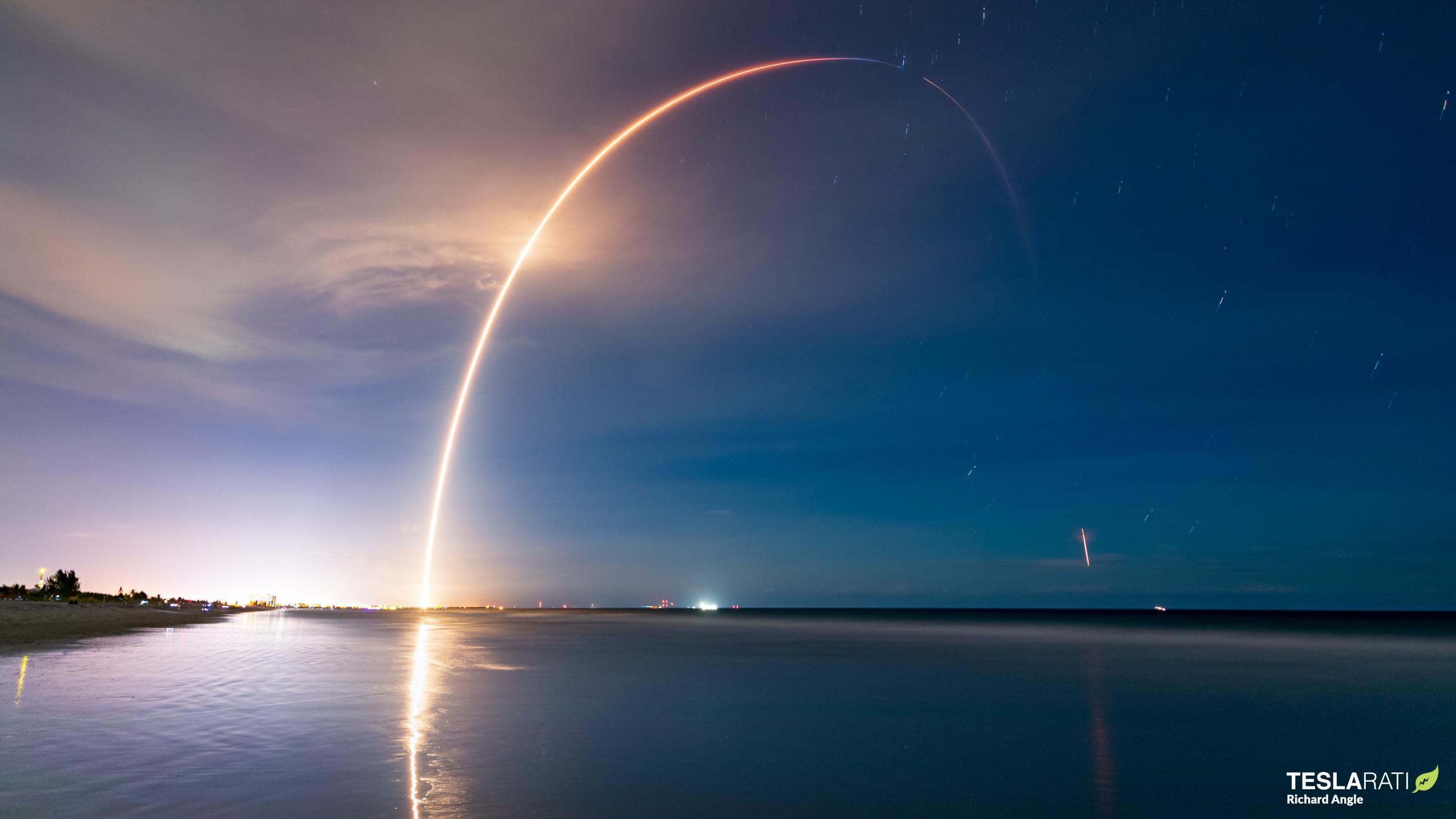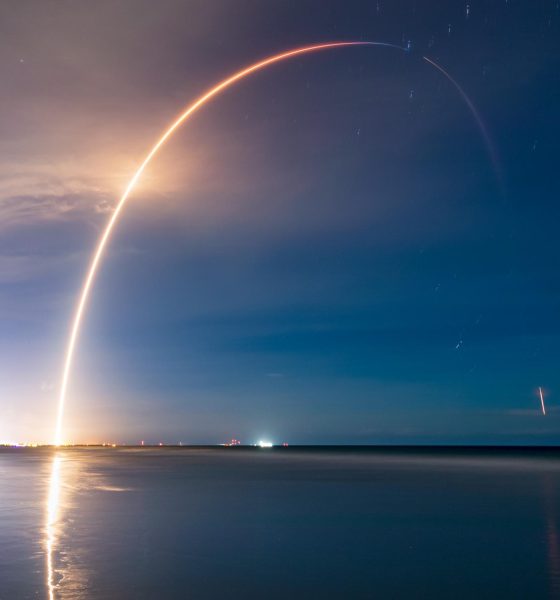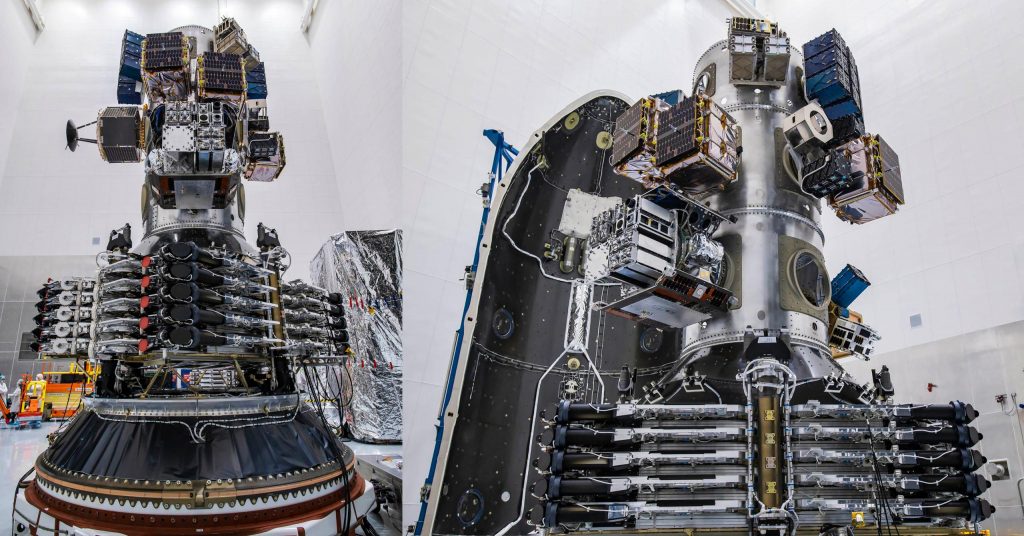

News
SpaceX sends Starlink satellites, Boeing demonstrator into orbit on 40th launch of 2022
SpaceX has completed its 40th Falcon 9 launch of 2022, delivering a new batch of Starlink satellites and Boeing demonstration satellite into orbit.
Right on schedule, Falcon 9 lifted off from SpaceX’s Cape Canaveral Space Force Station (CCSFS) LC-40 pad at 10:09 pm EDT, Sunday, September 4th. The rocket’s reused booster and fairing and new upper stage performed as expected, continuing Falcon 9’s unprecedented streak of 149 successful launches. Flying for the seventh time overall, former Falcon Heavy booster B1052 performed flawlessly after a quick 31-day turnaround and touched down on SpaceX drone ship Just Read The Instructions’ (JRTI) deck several hundred miles downrange less than nine minutes after liftoff.
Flying for the fourth and fifth times, the Starlink 4-20 mission’s Falcon 9 fairing halves also worked as expected on ascent. SpaceX does not discuss fairing recovery but both halves likely deployed parafoils after reenter Earth’s atmosphere and gently splashed down in the Atlantic Ocean. SpaceX support ship Doug will eventually fish them out of the water for reuse.
Not merely a Starlink mission, Starlink 4-20 was SpaceX’s sixth Starlink rideshare. Sitting atop the stack of 51 Starlink V1.5 satellites was an experimental spacecraft built by Spaceflight Inc. Known as Sherpa-LTC2, Spaceflight and partner Astro Digital turned the orbital transfer vehicle (space tug) into a satellite for customer Boeing. The purpose: carry and test a prototype communications payload built by Astro Digital and designed to verify new V-band communications technologies for a planned constellation of Boeing satellites in Low Earth Orbit (LEO).
The US Federal Communications Commission (FCC) approved Boeing’s plans for a 147-satellite V-band constellation in November 2021. It’s unclear what the purpose of the constellation would be or if Boeing already has customers or partners lined up. The prototype spacecraft built by Spaceflight and Astro Digital – known as Varuna in recent FCC filings – will be crucial for determining the constellation’s future. Boeing wants to use a swath of spectrum known as the V-band that has a higher frequency than the Ku and Ka bands commonly used by most other communications satellites. A higher frequency could mean higher connection speeds and more available bandwidth, but V-band radio waves tend to struggle to pierce through rain and other adverse weather conditions.
Varuna should help Boeing fully determine whether that interference is a showstopper or something that can be managed. Boeing applied for an FCC license for its V-band constellation in 2017. It’s unclear whether a lack of interest on Boeing’s part or problems with the application caused the process to take as long as it did.
Varuna was successfully deployed from Falcon 9 a bit less than 50 minutes later in a mostly circular orbit 316 kilometers (196 mi) above Earth’s surface. Outfitted with a propulsion system designed by startup Benchmark Space, Sherpa-LTC2 is meant to eventually raise itself into an operational orbit around 1050 kilometers (~650 mi), where the V-band payload can be tested at the same altitude as Boeing’s planned constellation.

20 minutes after Varuna’s deployment, Falcon 9’s upper stage – spinning end over end – released all 51 Starlink satellites at once, completing the payload portion of the mission. As always, the upper stage will likely perform a deorbit burn within a few hours of liftoff and should reenter Earth’s atmosphere not long after, ensuring that the only space debris produced by the mission is the Varuna deployment mechanism and a set of four benign Starlink ‘tensioning rods’ that should reenter in about two months.
Starlink 4-20 was SpaceX’s 40th launch of 2022 and 50th launch in 12 months. According to Next Spaceflight, the company has plans for at least two more Starlink launches within the next eight days. Starlink 4-2, another rideshare mission, is scheduled no earlier than September 10th, while Starlink 4-34 could launch on September 12th.

News
Tesla starts showing how FSD will change lives in Europe
Local officials tested the system on narrow country roads and were impressed by FSD’s smooth, human-like driving, with some calling the service a game-changer for everyday life in areas that are far from urban centers.

Tesla has launched Europe’s first public shuttle service using Full Self-Driving (Supervised) in the rural Eifelkreis Bitburg-Prüm region of Germany, demonstrating how the technology can restore independence and mobility for people who struggle with limited transport options.
Local officials tested the system on narrow country roads and were impressed by FSD’s smooth, human-like driving, with some calling the service a game-changer for everyday life in areas that are far from urban centers.
Officials see real impact on rural residents
Arzfeld Mayor Johannes Kuhl and District Administrator Andreas Kruppert personally tested the Tesla shuttle service. This allowed them to see just how well FSD navigated winding lanes and rural roads confidently. Kruppert said, “Autonomous driving sounds like science fiction to many, but we simply see here that it works totally well in rural regions too.” Kuhl, for his part, also noted that FSD “feels like a very experienced driver.”
The pilot complements the area’s “Citizen Bus” program, which provides on-demand rides for elderly residents who can no longer drive themselves. Tesla Europe shared a video of a demonstration of the service, highlighting how FSD gives people their freedom back, even in places where public transport is not as prevalent.
What the Ministry for Economic Affairs and Transport says
Rhineland-Palatinate’s Minister Daniela Schmitt supported the project, praising the collaboration that made this “first of its kind in Europe” possible. As per the ministry, the rural rollout for the service shows FSD’s potential beyond major cities, and it delivers tangible benefits like grocery runs, doctor visits, and social connections for isolated residents.
“Reliable and flexible mobility is especially vital in rural areas. With the launch of a shuttle service using self-driving vehicles (FSD supervised) by Tesla in the Eifelkreis Bitburg-Prüm, an innovative pilot project is now getting underway that complements local community bus services. It is the first project of its kind in Europe.
“The result is a real gain for rural mobility: greater accessibility, more flexibility and tangible benefits for everyday life. A strong signal for innovation, cooperation and future-oriented mobility beyond urban centers,” the ministry wrote in a LinkedIn post.
News
Tesla China quietly posts Robotaxi-related job listing
Tesla China is currently seeking a Low Voltage Electrical Engineer to work on circuit board design for the company’s autonomous vehicles.

Tesla has posted a new job listing in Shanghai explicitly tied to its Robotaxi program, fueling speculation that the company is preparing to launch its dedicated autonomous ride-hailing service in China.
As noted in the listing, Tesla China is currently seeking a Low Voltage Electrical Engineer to work on circuit board design for the company’s autonomous vehicles.
Robotaxi-specific role
The listing, which was shared on social media platform X by industry watcher @tslaming, suggested that Tesla China is looking to fill the role urgently. The job listing itself specifically mentions that the person hired for the role will be working on the Low Voltage Hardware team, which would design the circuit boards that would serve as the nervous system of the Robotaxi.
Key tasks for the role, as indicated in the job listing, include collaboration with PCB layout, firmware, mechanical, program management, and validation teams, among other responsibilities. The role is based in Shanghai.
China Robotaxi launch
China represents a massive potential market for robotaxis, with its dense urban centers and supportive policies in select cities. Tesla has limited permission to roll out FSD in the country, though despite this, its vehicles have been hailed as among the best in the market when it comes to autonomous features. So far, at least, it appears that China supports Tesla’s FSD and Robotaxi rollout.
This was hinted at in November, when Tesla brought the Cybercab to the 8th China International Import Expo (CIIE) in Shanghai, marking the first time that the autonomous two-seater was brought to the Asia-Pacific region. The vehicle, despite not having a release date in China, received a significant amount of interest among the event’s attendees.
Elon Musk
Elon Musk and Tesla AI Director share insights after empty driver seat Robotaxi rides
The executives’ unoccupied tests hint at the rapid progress of Tesla’s unsupervised Robotaxi efforts.

Tesla CEO Elon Musk and AI Director Ashok Elluswamy celebrated Christmas Eve by sharing personal experiences with Robotaxi vehicles that had no safety monitor or occupant in the driver’s seat. Musk described the system’s “perfect driving” around Austin, while Elluswamy posted video from the back seat, calling it “an amazing experience.”
The executives’ unoccupied tests hint at the rapid progress of Tesla’s unsupervised Robotaxi efforts.
Elon and Ashok’s firsthand Robotaxi insights
Prior to Musk and the Tesla AI Director’s posts, sightings of unmanned Teslas navigating public roads were widely shared on social media. One such vehicle was spotted in Austin, Texas, which Elon Musk acknowleged by stating that “Testing is underway with no occupants in the car.”
Based on his Christmas Eve post, Musk seemed to have tested an unmanned Tesla himself. “A Tesla with no safety monitor in the car and me sitting in the passenger seat took me all around Austin on Sunday with perfect driving,” Musk wrote in his post.
Elluswamy responded with a 2-minute video showing himself in the rear of an unmanned Tesla. The video featured the vehicle’s empty front seats, as well as its smooth handling through real-world traffic. He captioned his video with the words, “It’s an amazing experience!”
Towards Unsupervised operations
During an xAI Hackathon earlier this month, Elon Musk mentioned that Tesla owed be removing Safety Monitors from its Robotaxis in Austin in just three weeks. “Unsupervised is pretty much solved at this point. So there will be Tesla Robotaxis operating in Austin with no one in them. Not even anyone in the passenger seat in about three weeks,” he said. Musk echoed similar estimates at the 2025 Annual Shareholder Meeting and the Q3 2025 earnings call.
Considering the insights that were posted Musk and Elluswamy, it does appear that Tesla is working hard towards operating its Robotaxis with no safety monitors. This is quite impressive considering that the service was launched just earlier this year.








